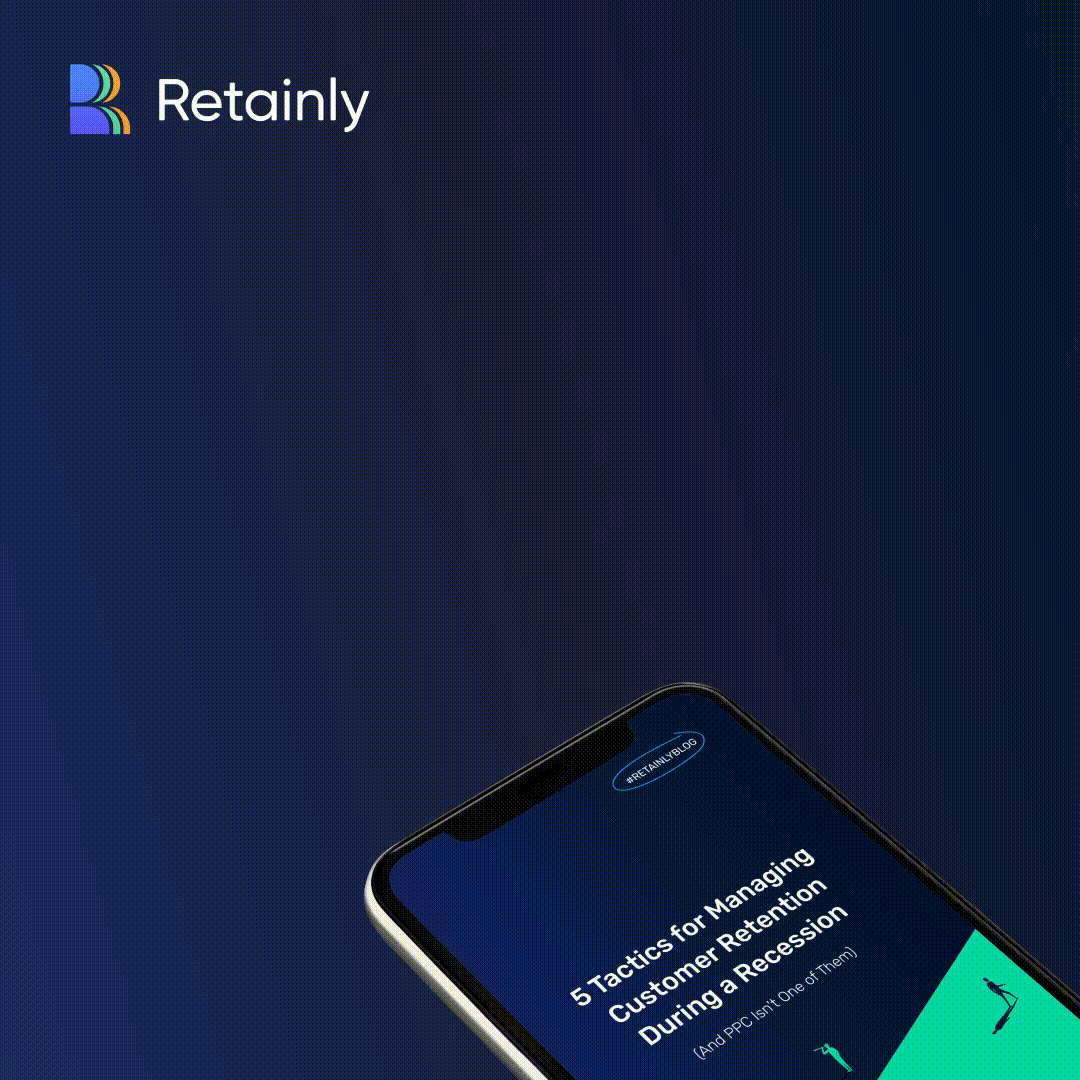5 Tactics for Managing Customer Retention During a Recession
Talks of an impending recession are racking the business scene. And there you are. A marketing specialist that has to optimize marketing costs but still somehow keep clients coming — and staying. Easier said than done, especially with all the marketing budget cuts and diminishing company profits. Meanwhile, the competition on the market grows, and so do the advertising costs.
We feel you, friend. Being a marketing business, we know that Google, Meta, and LinkedIn ads might be your first guess for customer retention during a recession. But they’re sneaky monopolists that make advertising costs go up (unlike the results of those ads). If you’re looking for new, efficient, and affordable customer retention strategies, we’ve got five of them right here. Believe us, challenging paid promotion channels and using alternatives like web pushes, emails, and other marketing automation features will do wonders for your business and budget.
But before we get down to the tips and tricks of thriving in a recession, let’s revisit the basics of customer retention.
Customer retention: What is it, and how do you measure it?

Customer retention is a long-term strategy that makes your business sustainable. Think of it like a successful TV series. Loyal fans can’t wait for the next episode and will even watch reruns, a spin-off, or spend their time discussing the possibility of the show being renewed rather than waste their time on yet another show. Your company has to be their “Friends.”
Now, let’s take a closer look at the meaning of customer retention.
What is customer retention?
Customer retention is all about a company’s ability to keep customers loyal to their business. Naturally, it includes practices that increase satisfaction and make people want to buy your products over and over again.
How do you calculate customer retention rate?
Simple. Use the customer retention rate as a metric for assessing the number of customers that stick with your company over a set period.
You’re welcome to calculate the customer retention rate using this formula: CRR = ((E-N)/S) x 100. Here’s how you do it:
- Determine the number of customers you’ve acquired at the end of the time period (E).
- Subtract the number of new customers you acquired within the given period (N).
- Divide the result by the number of customers you had at the beginning of the period (S).
- Multiply the result by 100 to see the percentage.
Did you hit over 85%? Excellent — that’s the perfect result! But if your numbers are lower, it’s time to work on improving your customer retention strategies.
Customer retention in the time of a recession
Two-thirds of the economists that participated in a World Economic Forum poll believe a recession is likely to happen in 2023. Marked by a decline in economic activity, a recession often means reduced consumer spending, industrial output, and employment. And you know what that leads to — declining sales and profits for businesses.
The good news is that a mere 5% increase in customer retention can result in 25% to 29% of revenue growth. And did you know that around 50% of a company’s revenue comes from 8% of its loyal customers? Impressive, indeed.
So, revving up your customer retention strategy can help you stay resilient throughout the economic downturn. But how exactly do you go about it? Spoiler: not with paid promotion.
5 Customer retention strategies and tactics to recession-proof your business

Now, let’s discuss the top strategies that will help you improve customer retention. How do you get your campaign up and running? With web pushes, smart email marketing, SMS, mobile pushes, and other marketing automation features like:
No PPC, Facebook or LinkedIn paid promos, thank you very much.
So, here’s what you can do to improve customer retention.
Create educational content
When you offer helpful, educational content to your clients, you channel two vibes: caring and trust. Stats prove that: educational content is associated with brand trust, and that trust keeps growing over time. So use the slight drop in leads to create video tutorials, how-to guides, quizzes, or ebooks about your products and associated services.
But before that, it’s important to really get to know your clients, their journeys, and the troubles they encounter most often:
- Organize customer data in a CRM system. Yes, you can also use your CRM as customer retention software. After all, it stores, organizes, and gives you easy access to customer profiles, contact information, past interactions, and issues.
- Run surveys to discover their problems. Whether it’s your services in particular or the industry in general, customers will have questions and issues. Outright asking them may show you what educational gaps have to be covered.
- Scout for reviews. More than that, focus on the bad ones. If you see some clients complaining about, say, the setup process that’s too complicated, use it as an opportunity to create learning materials about that.
Plus, gamifying the process with rewards and levels will keep them coming back. But more on rewards later.
Personalize for the love of marketing gods!
By now, you must have some data about your customers. Don’t just let it sit there — use it to bring your clients personalized user experiences.
This custom approach to customer engagement and retention is not a thing to be trifled with. Did you know that an unpersonalized experience can make 62% of consumers lose their loyalty to a brand? The number grew by almost 20% from 45% in 2021. At the same time, nearly half of respondents (49%) said a personalized shopping experience makes them consider shopping with this brand again.
With personalization, you’re free to send out tailored recommendations, retention emails, thank you notes, specific push messages, and SMSs with exclusive offers clients won’t be able to ignore. All on a budget.
It can be something as basic as sending re-engagement emails to customers who haven’t been active for a long time, greeting them on their birthdays, or congratulating them on a milestone. Or, if your team is up for that, you can provide a unique experience for every customer using a dynamic website that adapts its content based on the visitor’s data signals, such as demographics and behavioral data.
And don’t forget about segmentation! Putting clients into different categories based on age, income, purchase history, etc., is your first step toward personalization.
Deliver excellent customer service
86% of customers believe good customer service can turn them from one-time buyers into advocates for the brand. You know what that means — exceptional customer service needs to be your priority. Whether it’s about a product return, a software bug, or a delivery issue, you have to do everything you can to help — and even more.
Here are a few ways to keep clients satisfied:
It all boils down to keeping your customers’ experiences with your brand as pleasant as possible.
Offer rewards they’ll enjoy
Coupons, bonuses, referral programs, or just small surprises — all of these have the potential to turn one-time buyers into loyal customers. Reward people for sticking with your brand, offer them special prices on subscriptions or secret promo codes. Exclusivity always makes people feel special.
You can try the following:
So what will it be? Personal discounts? Coupons? Bonuses for bringing a friend? Experiment with the loyalty program and offer new incentives to keep your customers interested.
Build a community around your brand
Use social media and community forums to bring your customers together. But don’t leave them on their own — assign admins to provide helpful information and assistance, engage with customers on social media, answer their questions, gather them for master classes or meetups.
It’a also important to build empathy and create a space for sharing. Customers who are emotionally invested in your brand won’t jump the fence even if your competitors offer more attractive prices.
Here are some ways to foster emotional connections with your customers:
Your goal is to make customers feel good about being associated with your brand. So, steer clear of actions and messages that contradict your core values. For instance, no matter how popular an influencer is, refrain from working with them if they’re going to put off your customer base.
Conclusion
A recession always poses challenges. But that doesn’t mean you should pour what’s left from your marketing budget into Google Ads. They won’t bring your clients back.
You know what will? An updated customer retention program that involves personalized SMSs (no, they’re not intrusive) or a customer-tailored email flow. In times of a recession, these customizable and cost-effective tools can help build the resilience you need.

Fortunately, you can automate this and other tasks like web and mobile push notifications to ease up the load. Why not try Retainly? This marketing platform automates customer segmentation, synchronizes with your CRM, and enables omnichannel communications. Book a demo to see for yourself.
